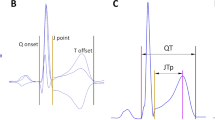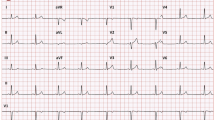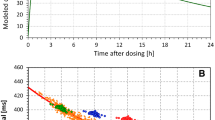Abstract
Background
Cardiac repolarization is assessed by the QT interval on the surface electrocardiogram and varies with the heart rate. Standard QT corrections (QTc) do not account for the lag in QT change following a change in heart rate (QT hysteresis). Our group has developed and tested a transfer function (TRF) model to assess the effectiveness of a dynamic model of QT/RR coupling in eliminating hysteresis.
Methods
We studied three groups: group I, healthy volunteers (n = 23, 41 ± 17 years); group II, hypertensive patients (n = 25, 45 ± 11 years); and group III, patients in a predominately paced rhythm (n = 5, 75 ± 6 years). To vary the heart rate, either exercise bicycling in the supine position (groups I and II) or manipulation of the pacemaker parameters (group III) was done. We then compared a dynamic TRF model with a model based on weighted averages of previous RR intervals. Two parameters were tested: root mean square (RMS) of the error signal between measured and computed QT and the elimination of hysteretic loops.
Results
TRF-based measurements eliminated hysteresis in 22/23 (95%) group I patients, 21/25 (84%) group II patients, and 4/5 (80%) group III patients. When hysteresis elimination was not complete, the QT drift that followed RR intervals was different before and after bicycling (100 ms). In these patients, the corresponding QT interval did not significantly change during this period. The TRF model was found superior to the other tested models with respect to both analyzed parameters (RMS and hysteresis elimination).
Conclusion
The TRF model limited QT hysteresis in healthy, hypertensive, and pacemaker-dependent patients. In addition, an important finding of QT drift in patients with hypertension was identified. With further study in these and other diseased states, the TRF model may improve our ability to measure accurately cardiac repolarization and to determine arrhythmia risk.






Similar content being viewed by others
Abbreviations
- TRF:
-
Transfer function
- ECG:
-
Electrocardiogram
- RMS:
-
Root mean square
- Ms:
-
Milliseconds
- RR:
-
Heart interval
- QTc:
-
QT corrected
References
Berger, R. D. (2004). Electrical restitution hysteresis: good memory or delayed response? Circulation Research, 94, 567–569.
Chauhan, V. S., Krahn, A. D., Walker, B. D., Klein, G. J., Skanes, A. C., & Yee, R. (2002). Sex differences in QTc interval and QT dispersion: dynamics during exercise and recovery in healthy subjects. American Heart Journal, 144, 858–864.
Couderc, J. P., Vaglio, M., Xia, X., et al. (2007). Impaired T-amplitude adaptation to heart rate characterizes I(Kr) inhibition in the congenital and acquired forms of the long QT syndrome. Journal of Cardiovascular Electrophysiology, 18, 1299–1305.
Extramiana, F., Maison-Blanche, P., Haggui, A., Badilini, F., Beaufils, P., & Leenhardt, A. (2006). Control of rapid heart rate changes for electrocardiographic analysis: implications for thorough QT studies. Clinical Cardiology, 29, 534–539.
Fossa, A. A., Wisialowski, T., & Crimin, K. (2006). QT prolongation modifies dynamic restitution and hysteresis of the beat-to-beat QT-TQ interval relationship during normal sinus rhythm under varying states of repolarization. The Journal of Pharmacology and Experimental Therapeutics, 316, 498–506.
Lauer, M. S., Pothier, C. E., Chernyak, Y. B., et al. (2006). Exercise-induced QT/R-R-interval hysteresis as a predictor of myocardial ischemia. Journal of Electrocardiology, 39, 315–323.
Watanabe, M. A. (2007). Lissajous curves and QT hysteresis: a critical look at QT/RR slope analysis techniques. Heart Rhythm, 4, 1006–1008.
Fenichel, R. R., Malik, M., Antzelevitch, C., et al. (2004). Drug-induced torsades de pointes and implications for drug development. Journal of Cardiovascular Electrophysiology, 15, 475–495.
Schwartz, P. J., Priori, S. G., Spazzolini, C., et al. (2001). Genotype-phenotype correlation in the long-QT syndrome: gene-specific triggers for life-threatening arrhythmias. Circulation, 103, 89–95.
Kapa, S., & Asirvatham, S. J. (2009). Atrial fibrillation: focal or reentrant or both?: A new autonomic lens to examine an old riddle. Circulation Arrhythmia and Electrophysiology, 2, 345–348.
Halamek, J., Jurak, P., Villa, M., et al. (2007). Dynamic coupling between heart rate and ventricular repolarisation. Biomedical Technology (Berlin), 52, 255–263.
Malik, M., Hnatkova, K., Novotny, T., & Schmidt, G. (2008). Subject-specific profiles of QT/RR hysteresis. The American Journal of Physiology, 295, H2356–H2363.
Pueyo, E., Smetana, P., Caminal, P., de Luna, A. B., Malik, M., & Laguna, P. (2004). Characterization of QT interval adaptation to RR interval changes and its use as a risk-stratifier of arrhythmic mortality in amiodarone-treated survivors of acute myocardial infarction. IEEE Transactions on Biomedical Engineering, 51, 1511–1520.
Starobin, J. M., Cascio, W. E., Goldfarb, A. H., et al. (2007). Identifying coronary artery flow reduction and ischemia using quasistationary QT/RR-interval hysteresis measurements. Journal of Electrocardiology, 40, S91–S96.
Lau, C. P., Freedman, A. R., Fleming, S., Malik, M., Camm, A. J., & Ward, D. E. (1988). Hysteresis of the ventricular paced QT interval in response to abrupt changes in pacing rate. Cardiovascular Research, 22, 67–72.
Franz, M. R., Swerdlow, C. D., Liem, L. B., & Schaefer, J. (1988). Cycle length dependence of human action potential duration in vivo. Effects of single extrastimuli, sudden sustained rate acceleration and deceleration, and different steady-state frequencies. The Journal of Clinical Investigation, 82, 972–979.
Padrini, R., Speranza, G., Nollo, G., et al. (1997). Adaptation of the QT interval to heart rate changes in isolated perfused guinea pig heart: influence of amiodarone and D-sotalol. Pharmacological Research, 35, 409–416.
Acknowledgments
The work was supported by Grant No. 102/08/1129 of the Grant Agency of the Czech Republic.
Author information
Authors and Affiliations
Corresponding author
Rights and permissions
About this article
Cite this article
Halámek, J., Jurák, P., Bunch, T.J. et al. Use of a novel transfer function to reduce repolarization interval hysteresis. J Interv Card Electrophysiol 29, 23–32 (2010). https://doi.org/10.1007/s10840-010-9500-x
Received:
Accepted:
Published:
Issue Date:
DOI: https://doi.org/10.1007/s10840-010-9500-x




